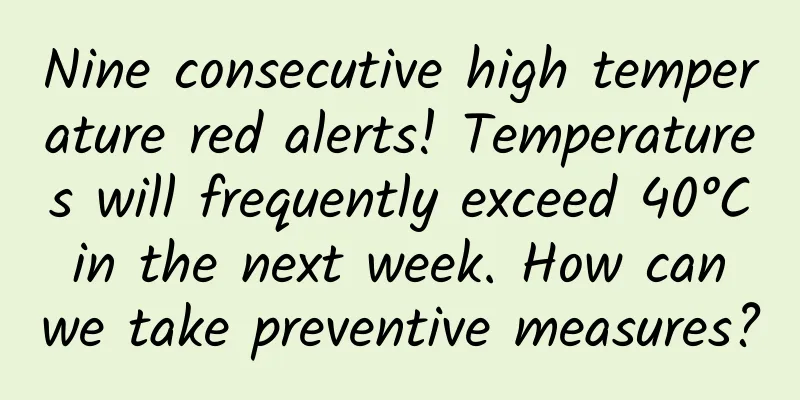Nine consecutive high temperature red alerts! Temperatures will frequently exceed 40°C in the next week. How can we take preventive measures?

|
Starting from August 30, high temperatures will return to Jiangnan, Jianghan, Jianghuai and other places. The highest temperature in Hubei, southeastern Anhui, Zhejiang, Jiangxi, northwestern Fujian, southern Guangdong, central and southern Guangxi will be 35-36℃, and above 37℃ in some places. Chongqing has issued red high temperature warning signals for nine consecutive days, and Sichuan has issued red high temperature warning signals for eight consecutive days! Due to the continued hot and sunny weather, Yuzhong District, Liangping District, Yunyang County of Chongqing, Zigong, Nanchong, Suining, Luzhou of Sichuan announced the delay of school opening. The Central Meteorological Observatory predicts that the temperature in the Sichuan Basin and Chongqing will remain relatively high in the next week, and the temperature in Chongqing will continue to maintain hot weather over 40°C . In the next week, high temperatures will continue in eastern Sichuan and Chongqing, with the highest temperature reaching 40-42°C. According to statistics, since August, the number of high-temperature days in Sichuan and Chongqing has exceeded 25 days, and the temperature in many places has exceeded 40°C. In particular, in late August, the number of days with continuous high temperatures exceeding 40°C in stations such as Shapingba, Beibei, Rongchang, Jiangjin in Chongqing, and Hejiang and Lu County in Sichuan reached 9-10 days. Is continued high temperature abnormal? According to meteorological experts, since July 31, an unusually strong subtropical high pressure landed and further developed westward, controlling a large area in southern my country. The subtropical high pressure control area is dominated by sinking airflow, which is not conducive to the formation of systematic precipitation clouds, and is often sunny, hot and high temperature. The intensity of high temperature depends on the intensity of the subtropical high pressure. Previously, the core of the subtropical high pressure covered the Yangtze River Delta region, so the intensity of high temperature in the Yangtze River Delta region was unusually prominent. The recent high temperatures in Sichuan and Chongqing are also due to the fact that they are under the control of a high-pressure system. The sky is clear with few clouds, and both the downward warming and the ground radiation warming are more obvious, so the daytime temperature is relatively high. The weather exceeding 40℃ is related to the special terrain of the river valley and mountains. Extremely hot weather can easily lead to heat stroke and heat stroke How to deal with the "roasting" test? In extremely hot weather, if you want to engage in outdoor activities, you should pay special attention to preventing heat stroke: (1) Choose the right time. Try to avoid outdoor exercise during the hot period between 12:00 and 15:00. It is best to choose the relatively cool time in the morning or evening. Even if you have outdoor activities at noon, try to reduce the time to less than 15 minutes to half an hour. (2) Pay attention to sun protection measures, wear loose, breathable, light-colored sportswear, and a wide-brimmed sun hat or straw hat. Under direct sunlight, the body's perceived temperature will rise by at least 5-10 degrees Celsius, so in an environment of 38 degrees Celsius, the perceived temperature without any shelter may reach 43-48 degrees Celsius; (3) Increase your water intake appropriately. You can choose beverages containing electrolytes. As long as the body can still sweat appropriately, the body's ability to regulate body temperature has not been lost. In addition, after working for a long time in a high temperature environment, if you experience sweating, thirst, dizziness, headache, high fever, etc., you should consider that you have suffered from heat stroke. The prognosis of heat stroke is related to the degree of high fever, duration, cooling speed, and the degree of damage to important organs. If treatment is delayed, the mortality rate can reach 80%; if it can be diagnosed early and treated with cooling in time, the mortality rate can be reduced to 10%. Although some heat strokes are very critical and severe cases have the risk of death, not all heat strokes require medical treatment. Generally, patients with premonitory heat stroke and mild heat stroke can return to normal after timely on-site rescue. However, patients with severe heat stroke should be transferred to the hospital immediately. The basic principles of treatment are to lower core body temperature and prevent organ failure. 1. Premonitory and mild heat stroke : Once discovered, immediately move to a cool, ventilated environment, remove clothing, take oral saline or salt-containing electrolyte drinks such as Pocari Sweat and Pulse, and wipe the whole body with a wet towel to cool down before recovery. For those who cannot drink water and are not conscious, send them to the hospital for intravenous rehydration. 2. Heat cramps : Follow the above-mentioned precursors and treatment methods for mild heatstroke and then seek medical attention promptly after initial treatment. Replenish with sufficient sugar and salt water, slowly stretch, massage and knead the spasmodic muscles to relax them, and antispasmodic and analgesic drugs can be used. 3. Heat exhaustion : Lay the patient flat, raise the lower limbs, and send him to a doctor promptly after initial treatment according to the above-mentioned warning signs and treatment methods for mild heat stroke. Cool him down quickly and promptly, replenish sugar and saline, restore blood volume, prevent hypotension, and ensure blood supply to important organs. 4. Heat stroke : Send to hospital promptly after first aid treatment on site, give oxygen and cool down. The cooling speed is closely related to the prognosis. The higher the body temperature and the longer the duration, the more severe the tissue damage and the worse the prognosis. The temperature should be reduced to below 39°C within 1 hour. Ice caps, ice blankets, and ice bags can be placed on the large arteries (carotid artery, axillary artery, femoral artery, popliteal artery, etc.). At the same time, 200ml of ice saline can be used for gastric or rectal lavage; 1000-2000ml of iced 5% glucose saline can also be used for intravenous drip, or low-temperature dialysate (10°C) can be used for hemodialysis. Supplement electrolytes, correct electrolyte disorders and acidosis; prevent and treat cerebral edema and convulsions; keep the respiratory tract unobstructed; prevent and treat organ dysfunction and gastrointestinal bleeding, etc. When driving a car or electric vehicle in hot weather, you should also pay attention to the following: Before traveling, check whether the line is aging, whether the tire pressure is too high or bulging, and take a rest during long-distance driving to let the tires cool down. Do not place flammable items such as perfume, air cleaner, lighters, etc. in the car to prevent fire caused by excessive temperature in the car. Remember, under no circumstances should children be left alone in the car. Comprehensive sources: Central Meteorological Observatory, CCTV News, Chinese Medical Association, etc. |
<<: The dead branches and leaves under your feet actually hide the big secret of global change!
Recommend
How to improve traffic conversion rate?
"Traffic anxiety" seems to make everyon...
Tik Tok promotion skills: 3 steps and 7 key points!
I don’t know since when, the paper advertisements...
A timely help? NIO completes $100 million convertible bond financing
Recently, NIO announced that it has signed a conv...
How to invest in selling products through Juleliang Qianchuan Video? Detailed process explanation
Recently, many friends have been discussing Julia...
Why Mars is the first choice for deep space exploration
Human exploration of Mars began in the 1960s. The...
MediaTek X20 running score exposed! Will you still cry and count money this time?
Recently, AnTuTu revealed the running score of Me...
What? The northeastern part of the Qinghai-Tibet Plateau has entered the "Early Anthropocene"! ?
The relationship between environmental evolution ...
How spectacular is the "gateway" of the One Valley and Nine Waterfalls? Uncovering the secrets of China's largest natural gneiss bridge
"A natural stone arch hanging over an eroded...
How to carry out operational promotion activities for the purpose of attracting new customers?
This article will share with you my thoughts on a...
Information flow advertising | The four basic principles of advertising monitoring, understand them and you can say goodbye to fake traffic!
This article is based on the gaming industry, but...
2021 Double 11-KOL Marketing Preparation Strategy Insights and Resources
The release of Double 11 commercial content is co...
As the transformation towards entertainment accelerates, why doesn’t NetQin take off its helmet?
After nearly 10 years of development, NetQin'...
Dingxiang Mama_Medical Cosmetic Surgery Guide 2021 Edition
Dingxiang Mama·Medical Cosmetic Surgery Guide 202...









